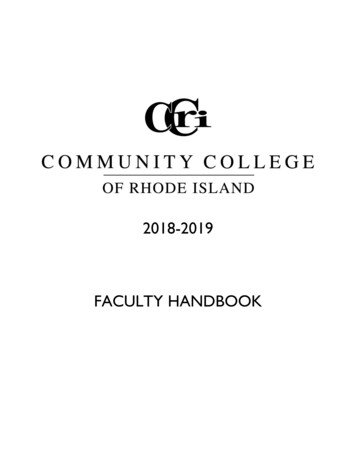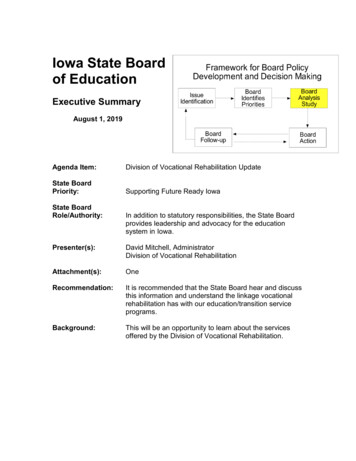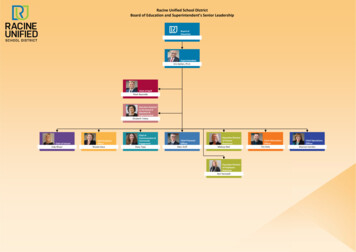
Transcription
COVERTDISCRIMINATIONTopeka—Before and After Brownby Robert Beatty and Mark A. PetersonA few Negro parents appeared Monday at several white elementary schools and requested permission to enroll Negro children, school officials confirmed Monday. The requests were denied bythe building principals in each case.The case of Reynolds vs. the Topeka Board of Education in the 1920s [sic] established authority of acity board of education to determine which school a child shall attend.1These sixty-two words inaccurately recount an effort aimed at school desegregation in Topeka, Kansas, as reported in the September 11, 1950, edition of the Topeka State Journal. At thesame time this cryptic passage describes the triggering event of Brown v Board of Educationof Topeka, Kansas, the 1954 landmark U.S. Supreme Court decision that theoretically openedthe doors of all white schools to black children. Cryptic, dismissive, inconsequential, unemotional—any of these words might be used to characterize this passage. It provides little portent ofthe social and political ramifications that followed from the mild confrontation played out that daywhen a few black parents with offspring in tow climbed the steps of elementary schools across the cityto request registration and attendance of their children at their neighborhood elementary schools.Robert Beatty is an assistant professor of political science at Washburn University. His interests, research, and projects in Kansas studiesfocus on history and politics, and he has written extensively about Topeka and the Brown v Board decision. He also is the producer and moderator for public affairs programming on KTWU and WUCT in Topeka. Mark Peterson earned his Ph.D. at the University of New Mexicoand is an assistant professor of political science at Washburn University. His major fields of interest are public policy, urban planning, politics, and budgeting.1. “Enrollment Near 1,900 Forecast at Topeka High,” Topeka State Journal, September 11, 1950. The court case referred to herewas the 1903 Reynolds v Board of Education of Topeka, 66 Kan. 672 (1903). For an excellent analysis of the legal precedents to Brownv Board of Education of Topeka, see J. Morgan Kousser, “Before Plessy, Before Brown: The Development of the Law of Racial Integration in Louisiana and Kansas,” in Toward a Usable Past: Liberty Under State Constitutions, ed. Paul Finkelman and Stephen E. Gottlieb (Athens: University of Georgia Press, 1991), 213 – 70.Kansas History: A Journal of the Central Plains 27 (Autumn 2004): 146 –163.146KANSAS HISTORY
Barbara Irby and Richard Ridley pose as queen and king of the Topeka High School Rambler basketball team in1947. On the surface it may appear that Topeka High was a leader in equal rights by electing an ethnic couple forthis honor, but further examination reveals that Topeka High's Ramblers was an all-black team, created becauseblack students were not allowed on the high school's principal team, the Trojans. Furthermore, the event to electthe Rambler royal couple was sponsored by the "colored" advisory council, a separate group from Topeka High'smajor student governing assemblage, the all-white student council.COVERT DISCRIMINATION147
This article examines the public record and personalrecollections regarding white and black relations in Topeka at the mid-point of the twentieth century. It looks athow the press, some public officials, and private citizensportrayed race at that time and how the local press framedthe U.S. Supreme Court’s landmark decision that devolvedfrom these contemporary conditions. Topeka, it appearsfrom the record, was a community indisposed to acknowledging the reality of Jim Crow, the ugly manifestation of“separate but equal,” in its midst.2In 1950 Topeka was a city of seventy-nine thousandwith an African American population of roughly fivethousand.3 The black population was not homogeneously concentrated in a single neighborhood. Instead itwas scattered about the city in various pockets. By themid-1900s the black neighborhoods were of a size andcharacter that a small downtown business and professional community existed to serve their needs. This commercial district, known colloquially as “the Bottoms,” wasnortheast of Topeka’s main business community alongKansas Avenue and east along Fourth Street and adjacentblocks. The black business district included various smallrestaurants, doctors’ offices, law offices, the Apex (laterRitz) Theatre, secondhand stores, grocers, and so forth.4Thus, the black community was not large, or overly obtrusive, but of sufficient dispersion and size to presumablymake its existence known in the larger community. Thesocio-economic disparities between the black and whiteneighborhoods had been obvious within the communitysince the late days of the nineteenth century when Topeka’s famous Reverend Charles Sheldon had established his2. Our analysis of the Topeka scene in the early 1950s relied principally on the city’s two daily newspapers, as well as oral histories collected under the auspices of the Kansas State Historical Society and theBrown Foundation (duplicate copies archived in both the Library andArchives Division, Kansas State Historical Society and the Washburn University School of Law, Topeka; hereafter cited as Oral History Project),minutes of the Topeka School Board from 1948 until 1952 (McKinley Burnett Administration, USD 501, Topeka), and the work of historians, journalists, witnesses, and participants in the Brown case.3. U.S. Census Bureau data obtained and extrapolations made fromTopeka–Shawnee County Metropolitan Planning Agency, ComprehensiveMetropolitan Plan 2010, October 1990, 3-15 through 3-18.4. Douglas W. Wallace and Roy D. Bird, Witness of the Times: A History of Shawnee County (Topeka: Shawnee County Historical Society, 1976),251–54. See also the discussion and footnote in James N. Leiker, “Race Relations in the Sunflower State,” Kansas History: A Journal of the CentralPlains 25 (Autumn 2002): 225.148kindergarten for black children in the west–central part ofpresent Topeka known as Tennesseetown.5Observations on black life, status, and social acceptance in Topeka are available from a variety of sources.One example derives from a transcript of an interviewwith Maurita Davis, the daughter of McKinley Burnett, thelocal National Association for the Advancement of ColoredPeople (NAACP) chapter president during the Brown vBoard period. Topeka maintained four schools for AfricanAmerican children—Monroe, Washington, McKinley, andBuchanan — with grades kindergarten through eighth.These separate facilities were made possible by an 1879state statute that permitted cities of the first class (morethan fifteen thousand population) to segregate their elementary schools. But the lines of separation had not always been rigidly enforced. Some of Topeka’s black elementary students attended “white” schools. Davisrecalled, for example, that Sumner Elementary School—the neighborhood school where Oliver Brown unsuccessfully tried to enroll his daughter in the fall of 1950—hadserved both black and white students together until sometime in the pre-World War II era. This limited integrationended when reports of a fatal attack on a white student bya black student assailant in the Kansas City schools led theSumner School administration to segregate the school.6While Jim Crow conditions existed in Topeka, they seldom were enforced as authoritatively as in the South. Forexample, the Brown oral history transcripts make referenceto downtown restaurants and lunch counters that wouldsell to blacks but only “in a sack” to be eaten off thepremises, while other transcripts cite the existence of“Peanut Heaven” (blacks-only seating) in the balconies ofthe downtown movie theaters from the 1920s until the1950s. Yet the insults of the South’s ubiquitous signs announcing WHITES ONLY or COLORED ENTRANCEwere not nearly so evident in Topeka. Instead, social constraints came by personal direction and community-wideunderstandings of appropriate “colored” behavior.7 In5. Timothy Miller, “Charles M. Sheldon and the Uplift of Tennesseetown,” Kansas History: A Journal of the Central Plains 9 (Autumn 1986):125 – 37; Thomas C. Cox, Blacks in Topeka, Kansas, 1865 – 1915: A Social History (Baton Rouge: Louisiana State University Press, 1982).6. Maurita Davis, interview, July 15, 1994, Oral History Project, .7. That the discrimination was not harshly and visibly underlined bypublic signage does not mean that it was markedly less prevalent in public accommodations in Topeka than in other places where rejection ofKANSAS HISTORY
counterpoint, the grand department store of downtowning care” of its black citizens in spite of their lack of reTopeka, Pelletier’s, was reported to disregard the color ofsources and power.its customers, welcoming all who had the money to shopAfrican Americans could not use all of the city recre“upscale.” The community’s appreciation of the Yankeeational facilities, but a good swimming pool and athleticvirtues of thrift, hard work, material prosperity, and educafields were available to them in Central Park. As the plaintion seems to have permitted a degree of social acceptability for prosperous and professional blackfamilies. As this article will illustrate, this led to conflict within theblack community when efforts topursue and advance the NAACP’slawsuit were undertaken.Two strong forces aside fromrace hampered blacks—their relatively small numbers in the community, and their relative lack of economic power. In the main, Topekawas, like many American towns, acommunity of largely unreflectivewhite burghers sold on Americancapitalism, mainstreet boosterism,the Republican Party, and a Godwho would reward acts of piety andmoral uplift. The result was a condescending attitude toward localblacks who, if given vigorous inTopeka's black commercial district comprised various businesses including the Apex Theatre, phostruction regarding moral rectitude, tographed here with what appears to be a crowd of patrons in 1933.were perceived as having the potential to one day rise to the level of tolerable stepbrothers and stepsisters. Among the white poptiffs in the Brown case noted, the black and white elemenulation a number of malignant and bigoted brutes hadtary schools were very comparable, and secondary educaworn their bed linen and spouted racist jingoisms in suption was not segregated by facilities—although the Topekaport of the Ku Klux Klan in the 1920s and 1930s. But byschools’ administration went to great lengths to keep stuWorld War II the long and benevolent shadows of such mendents segregated in activities, athletics, and academics duras the Tennesseetown benefactor Reverend Charles Sheling ninth through twelfth grades, particularly at Topekadon and the founders of the Menninger Institute, togetherHigh School. For example, until the 1949 school yearwith the return of prosperity, had rooted out the more blaAfrican Americans could not play with white athletes ontant and offensive aspects of racism, and Topeka was “takthe high school’s basketball team, the Trojans, so blacks hadtheir own team. The Topeka High Ramblers had coaches,uniforms, cheerleaders, and transportation just as did theirwhite counterparts.8During a late 2002 interview, retired Kansas SupremeCourt Justice T. C. Lockett noted several forms of Jim Crowblacks as equals was more blatantly illustrated. See Richard Kluger, Simple Justice: The History of Brown v. Board of Education and Black America’sStruggle for Equality (New York: Alfred A. Knopf, 1976), 374 – 80; Mary L.Dudziak, “The Limits of Good Faith: Desegregation in Topeka, Kansas,1950–1956,” Law and History Review 5 (Summer 1987): 366 – 68.8. Topeka School Board minutes, September 26, October 18, 1949,263, 264. Thereafter, the Trojans were an integrated basketball team.COVERT DISCRIMINATION149
in Kansas. For example, public transportation—buses andrail coaches—in the 1940s and 1950s was integrated untilarriving at Arkansas City or other southern border citieswhere the conveyance would stop and blacks would moveto the back to “colored” seating before proceeding into Ok-their service had been recognized widely in the media.10President Harry S. Truman ordered the integration of theU.S. military in July 1948 (Executive Order 9981), andTopeka, with its supply depot and air force training facilities, clearly was aware of the influx of black service personnel during both theworld war and the Koreanconflict. The local newspapers portrayed racial issuesas being a Southern problem and not something thathad any immediate significance in Topeka.However, Charles Baston,a member of the TopekaNAACP since 1945, recalledthat when McKinley Burnett began to approach theschool board on a regularbasis regarding school segregation in 1947–1948, theBecause black students could not join Topeka High School's basketball team, they formed their own, the Ramblers. Photographed here (left to right) are Donald Anderson, Theresa Byrd, Samuel Jackson, Sara Jaco,board typically scheduledWilliam Booth, and Barbara Revelry enjoying the Rambler's end-of-the-season banquet in 1947.the NAACP’s request at theend of the agenda. Thus, thelahoma. When Justice Lockett played athletics for Washrepresentatives of the NAACP would present their conburn University in the early 1950s, the teams were intecerns at 11:30 P.M. or midnight, usually followed by pergrated and traveled together, but whenever travelingfunctory acknowledgment of the group’s concerns and asouth the black athletes would be housed with black famiquick motion for adjournment.11lies in the area of the contest and could not eat with theIn fact, accommodation and diligent effort to affordteam in public restaurants. Similar observations were“separate but equal” facilities seemed to be hallmarks offound in the archived transcripts of two black formerthe Topeka school district. Guided since 1941 by the patriTopeka athletes, Joe Douglas and Jack Alexander.9cian superintendent Kenneth McFarland, the district hadhired a substantial number of credentialed African Ameriy the time the local NAACP, led by McKinley Burcan teachers to serve the needs of the K–8 black schools.nett, began petitioning the Topeka School Board inWhen Brown became a focus of national media attention,the late 1940s to end school segregation, the city althe photo image of Oliver Brown’s daughters walkingready had black police officers and firemen (albeit not inalong the railroad tracks adjacent to First Street to reachcommand positions and not part of integrated serviceMonroe School became part of the iconography of theunits). The Second World War had exposed many returning service men and women to black soldiers and sailors.Military units of color had distinguished themselves, andB9. T. C. Lockett, interview by authors, December 6, 2002. See also JackAlexander, interview, October 1991, Oral History Project; Joe Douglas, interview, October 24, 1991, ibid.15010. Just such an occasion related to the Korean conflict was noted bythe authors while researching newspapers from the time of the first casehearing. See “Mother of J. R. Bryant Gets Silver Star,” Topeka Daily Capital,February 13, 1951.11. Charles Baston, interview, May 14, 1992, Oral History Project.KANSAS HISTORY
movement.12 In fact, black elementary schoolchildren, while1951 election the board consisted of a new bank executive,undoubtedly having to walk some distance and thereby exa new lawyer, and a Washburn University political scienceposing themselves to dangerous downtown rush-hour trafprofessor to replace one of the business owners. The rest offic or the hazards of crossing railroad tracks, were mostlythe board members retained their seats. In fact, the onlywalking to bus stops where the district’s bus contractor“person of the people” elected to the school board duringwould pick them up and transport them to theirschools. In other words, the school district wasspending additional resources to bus black childrento distant segregated schools rather than permitthem to integrate into the extensive network ofneighborhood elementary schools that white children attended without busing.13McFarland and his black director of Negro education, Harrison Caldwell, were the focus of resentment among some in the African American community. In 1951 the community as a whole, owing tonewspaper charges of financial misdeeds, turnedout half of the Topeka school board, and the newboard soon divested itself of both McFarland andCaldwell.14 Paul Wilson, the young assistant attorney general for the State of Kansas who was assigned to the case by Attorney General HaroldFatzer, noted that the (old) board against which theNAACP filed suit “was hardly representative of thepopulation served by the public school system. All Topeka school district superintendent Kenneth McFarland (left) and director ofof its members were white. All were prosperous. Negro education Harrison Caldwell (right) were the focus of resentment amongsome in the African American community. Many believe McFarland supportedNone wore blue or unstarched collars. All lived on school segregation, and Caldwell was thought to be instrumental in stifling anythe ‘right’ side of town.”15restiveness in the ranks of the African American faculty.The election did not substantially alter thesocio-cultural makeup of the board. Prior to the 1951election the members were variously a bank executive, anthe Brown period came in 1954 when a local pest extermiofficer of Pelletier’s department store, a lawyer, two businator was elected. Throughout the period the board wasness owners, and the wife of the owner of a prominent realwhite, middle to upper-middle class, and uniformly inestate, insurance, and investments brokerage. After thecluded one female member. City Hall reflected the sameracial makeup but lacked the female member of the governing body.16In the black community the efforts of the local NAACP12. The photo appeared in the May 31, 1954, edition of Life magazine.tobringabout school integration were not uniformly wellIn an interview with Leonard Sykes Jr. of the Milwaukee Journal Sentinelreceived. In fact, little notice was taken of the activities ofpublished on its website www.jsonline.com/news/metro/jan04/204053.asp entitled “Legacy of Brown case a mix of hope, frustration,”the NAACP. Paul Wilson reported that when the state atCheryl Brown Henderson, Linda Brown’s younger sister and spokespertorney general’s office sought impressions from theson for the Brown Foundation, commented, “He [the Life photojournalist]put a story together with that photograph, and that became one of theAfrican American community, the attorney general’sprevailing myths.”“black friends advised him that few blacks were interested.13. For yet another version, see Kluger, Simple Justice, 408.14. McFarland went on to become a successful lecturer on Americanism on behalf of General Motors Corporation. The family retains someprominence in the Topeka community, as his daughter Kay McFarland isthe sitting chief justice of the Kansas Supreme Court.15. Paul E. Wilson, A Time to Lose: Representing Kansas in Brown vBoard of Education (Lawrence: University Press of Kansas, 1995), 17.16. Polk’s Topeka City Directory, 1948, 1950, 1952, 1953, 1955 (KansasCity, Mo.: R. L. Polk & Co.).COVERT DISCRIMINATION151
Most, they said, regarded the Topeka NAACP as troublemakers and did not support them.”17 Undoubtedly one ofthe chief concerns of the black middle class was the fateawaiting the black teachers in the Topeka school system ifthe schools were integrated. After the first argument ofOn April 6, 1953, the Topeka Daily Capital ran a storyheadlined “Negro Teacher Purge Begins in Kansas.”18 Thestory was prompted by a letter from the new Topeka schoolsuperintendent Wendel Godwin, who wrote on March 13,1953, to black schoolteacher Darla Buchanan and otherstelling them that “It is not possible at this time to offer youemployment for next year. . . . the majority of people inTopeka will not want to employ Negro teachers next yearfor white children.”19The fallout from Brown for the black teaching profession was summarized by Dorothy E. Scott in an interviewfor the Brown v Board Oral History Project on January 27,1992. Scott was one of the recipients, forty years earlier, ofGodwin’s letter:As I told you there were some schools where blackscould go anyway. There were some. That was whatthey were saying; if they closed the school there won’tbe any jobs for black teachers. That’s why a fight hadto be done. If you close the schools, you’ll have toopen up the white schools. See, they weren’t open toblack teachers. That was the problem all the time.They could have always put some children, stuckthem different places. What are you going to do withthe teachers? They aren’t in the white schools. Thatwas it. You can’t close these schools and just throwthese teachers to the wolves. The fight began. Firstthey eased one, I don’t know the school. I was aboutthe third black one that they moved over to this schoolwhere the man went up and down the whole neighborhood and asked would they let me do the teaching. He told me. I don’t know . . . I’ve often asked myself, “Would you have told that person that?”An analysis of Topeka’s two daily newspapers, theTopeka Daily Capital and the Topeka State Journal, around thetime of Brown (January 1950 to August 1951) also enhancesour understanding of the community’s attitudes towardand awareness of race. This time period includes the onsetand local resolution of the initial Brown v Board suit. Theanalysis reveals the publicly reported reactions of theschool board, the editorial and news elements of the twoIn March 1953 Superintendent Wendel Godwin believed, "the majority of people in Topeka will not wantto employ Negro teachers . . . for white children," andthe Topeka Daily Capital, April 6, 1953, reported that"Ironically, the Negro public school teachers in Kansasapparently will suffer most should the pending U.S.Supreme Court decision outlaw segregation."Brown and the associated cases before the U.S. SupremeCourt in December 1952, the count of students and teachers in the four Topeka black elementary schools was 729and 27, respectively.17. Wilson, A Time to Lose, 86.15218. Anna Mary Murphy, “Negro Teacher Purge Begins in Kansas,”Topeka Daily Capital, April 6, 1953.19. Richard E. Jones, “Brown v. Board of Education: Concluding Unfinished Business,” Washburn Law Journal 39 (Winter 2000): 191.KANSAS HISTORY
dailies, and the published public reaction to race storiesand issues.20During this time the nation was deeply engaged inthe conflict on the Korean peninsula. PresidentTruman was at his most beleaguered as a result ofalleged scandal in the Reconstruction Finance Corporationand over questions about Communist infiltration of theU.S. Department of State. Issues of race seem almost irrelevant to Kansas as judged by capital city newspaper coverage. At almost no time during the twenty-month periodstudied did either paper publish an editorial on race, integration of the Topeka schools, or the NAACP-led courtcase.21As noted previously, a brief passage in the Topeka StateJournal of September 11, 1950, recounted the efforts ofblack parents to register their children at neighborhoodschools. The following day, the Topeka Daily Capital reported the same news and noted that the parents “were refused on grounds that the board of education has the authority to decide which school a child attends. Four Negroschools are available.”22 A month earlier a Topeka Daily Capital article entitled “Petro New Head of School Board” indicated that segregation was of much greater significancethan indicated by editorial policy, general news coverage,or published public reaction. According to that article, theboard took up the issue of the Negro elementary schools asa specific agenda item and agreed to continue operatingthem. Further down the column it was stated that:A delegation of NAACP representatives appearedbefore the board to request elimination of segregationin the lower grades.Heading the NAACP delegation was McKinleyL. Burnett, president. Others were A. L. Napew, Mrs.One Topeka teacher who fortunately was able to retain herjob was Mamie Williams, photographed here some yearsbefore Brown. During her long and distinguished careerin Topeka, Williams taught at Buchanan and MonroeSchools and was principal at Washington School.20. The authors paid particular attention to the midweek (Wednesday and Thursday) editions because of the published reports of the regular meetings of the city commission and the school board and to the Sunday editions (Topeka Daily Capital) in which the editorials often took onmatters of community concern. The authors also examined the records ofthe school board during this time and earlier for the development of aricher understanding of the community context.21. Dudziak, “The Limits of Good Faith: Desegregation in Topeka,Kansas, 1950–1956, “ 369, recounted the editorial position of the TopekaDaily Capital on June 8, 1950, regarding Georgia governor Herman Talmadge’s obstreperous response to two U.S. Supreme Court decisions ofthat year on the subject of admitting blacks to, at the time, segregatedstate-operated, professional and graduate education institutions. Approving the high court’s decision and lamenting the governor’s flouting of thefourteenth amendment, the paper wrote: “The recent Supreme Court decisions ‘open the way for a square deal for a race that has been woefullymistreated in the southern states” (emphasis added).22. Topeka State Journal, September 11, 1950; “Schools Get Down toWork Today,” Topeka Daily Capital, September 12, 1950.Alvin Todd, Charles E. Bledsoe, and James B.Richardson.[Former school board president A.H.] Savillesuggested that the group appeal to the Legislature toamend the law permitting the existence of suchschools.2323. Topeka Daily Capital, August 8, 1950. The minutes of the schoolboard are more cryptic than the newspaper account. They record, “A committee, with Mr. Burnette [sic] as chairman, called on the Board to make arequest that the colored elementary schools not be segregated. No actionwas taken.” See Topeka School Board, minutes, August 7, 1951, 281.COVERT DISCRIMINATION153
The community was told one week later that theNAACP would have a mass meeting in protest of the decision not to admit black children to the segregated schoolsin their neighborhoods. The paper later would report onthe re-election of McKinley Burnett as president of theIn the fall of 1950, following the failed efforts of black parents to enroll their children in Topeka's white schools, theNAACP called a mass meeting at the Municipal Auditorium to protest the action of the Topeka school board. Thisbrief account of the meeting was published on page nine ofthe September 17, 1950, issue of the Topeka Daily Capital.local NAACP chapter, along with a slate of directors.24Those brief stories constituted the sum of all news coverage regarding Topeka’s black community and the questionof school desegregation during the fall school term of 1950.Then, on Wednesday, February 28, 1951, the NAACPfiled suit against “the Topeka Board of Education, School24. “NAACP Holds Protest Meeting at Auditorium,” Topeka DailyCapital, September 17, 1950; “M. L. Burnett Re-Named Topeka NAACPHead,” ibid., December 2, 1950.154Supt. Kenneth McFarland and Prin. Frank Wilson of Sumner school.”25 Once again no editorial mention was madeof the suit, and no letters appeared from either distressedor supportive members of the public. On March 4 the DailyCapital published a brief story announcing a dinner recognizing the annual scholarship activity of the Topeka Colored Parent–Teacher Council at Monroe School. The guestspeaker was to be Kenneth McFarland, named defendantin the lawsuit.26The next mention of the controversy, now a federalcase, came in the March 8 edition of the Daily Capital. Herea little story headlined “Topeka Teachers Get 300 Raise”told, in the fifth of six paragraphs, of the board’s discussion of the case and subsequent decision to instruct “theboard attorney, Lester Gooddell to prepare a defense in thetest case.” Journalist Richard Kluger reported that theboard fully expected a less than vigorous defense and thusrelief from any responsibility for an ensuing appeal of thecourt decision.27March 1951 brought elections for both the Topekaschool board and the Topeka City Commission. The primary election was scheduled for March 20, with the general election then following two weeks later. A voter’s guidestory appeared the Sunday before the primary, providingcandidate-submitted statements regarding their individualcampaign issues positions. Since both slates were nonpartisan, no party affiliations were identified and no partisanendorsements made. Among all the candidates only one,Harry Hargrave, challenger for the municipal parks commissioner position, made any reference to topics thatmight be construed as racial. Two items in his slate of positions—Item 4: ”Eliminate discrimination in the use ofparks and public buildings,” and Item 5: “Prompt actionon commission matters in accordance with serving the majority and without yielding to high-pressure minorities25. Both papers covered the filing although the Topeka State Journalprovided the fuller account as well as elucidating remarks concerning thestatutory basis of the district’s segregation practices. See “SeparateSchools a Target in Court,” Topeka State Journal, February 28, 1951, and“Anti-Segregation Suit to be Filed,” Topeka Daily Capital, February 28,1951. The following day the Topeka Daily Capital ran a follow-up story onpage five that reiterated the previous day’s content with the addition ofthe names of five of the plaintiffs: Oliver Brown, Mrs. Richard Lawton,Sadie Emanuel, Lucinda Todd, and Iona Richardson.26. “Colored P.-T.A.
Archives Division, Kansas State Historical Society and the Washburn Uni-versity School of Law, Topeka; hereafter cited as Oral History Project), minutes of the Topeka School Board from 1948 until 1952 (McKinley Bur-nett Administration, USD 501, Topeka), and the work of historians, jour-nalists, witnesses, and participants in the Brown case. 3.










